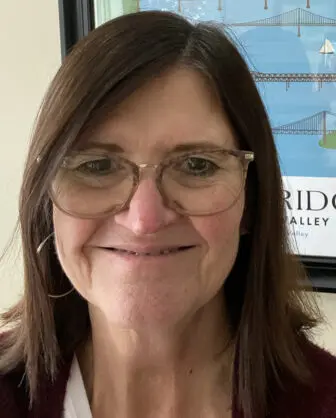Kathryn Burke, who lives in Newburgh, is director of the nonprofit Historic Bridges of the Hudson Valley (hbhv.org) and the author, most recently, of Bridges of the Mid-Hudson Valley.
 When did you become interested in bridges?
When did you become interested in bridges?
I’d always loved the Images of Modern America book series and thought I could write one. My husband and I were driving over the Newburgh-Beacon Bridge and he said, “Why don’t you write about the bridges?” Once I had finished Hudson River Bridges [in 2007], the New York State Bridge Authority [which operates the Newburgh-Beacon, Bear Mountain and four other bridges over the Hudson] contacted me about setting up Historic Bridges. When I retired from teaching in 2016, I became its first director.
Why was the group created?
We educate people about the bridges, but it’s also tied to STEM [science, technology, engineering and math]. We host workshops for teachers and students at the bridges. We have a classroom at the Bear Mountain Bridge and a museum created by Richy Vacek, a longtime foreman who died in 2021. We want to make a connection between STEM lessons and the real world, and the careers that we need people to fill. Skilled labor should be valued more than it is.
Which bridge was the first of the five?
Bear Mountain, which opened on Thanksgiving Day in 1924. We’re going to start our celebration of the centennial in March of this year by burying a time capsule at Bear Mountain. It was the first vehicular crossing over the Hudson River and, at the time, the longest suspension bridge in the world. The design of the bridge informed other suspension bridges, such as the George Washington [1927] and Golden Gate [1937], although those are full spans, with towers in the water.
Before the Bear Mountain Bridge was built, there was a huge outcry because people said it would destroy the look of the Highlands, but any photo taken at a distance shows how the bridge mimics the lines of the mountains. It’s gorgeous. Notably, to create an unobstructed view, the engineers dipped the cables below the roadway. If you drive across the Mid-Hudson Bridge, you can’t look down at the river because of the way the “pork chops” for the suspension ropes are positioned. But on the Bear Mountain Bridge, other than the sidewalk railing, you can see right through.

Peregrine falcons nest on the Bear Mountain Bridge, but the Bridge Authority takes a different attitude toward ospreys. Why is that?
It’s not that we don’t like them; it’s that they’re way too big to be on the towers. Their nests — which are made with huge branches, not twigs — slide off. That can be dangerous if they fall onto the roadway. The falcons fly above the bridge but they’re not dropping things on cars. Their habitats are below the bridge.
The Newburgh-Beacon Bridge opened in 1963 as a two-lane span, is that right?
Yes. In all fairness to [Gov. Nelson] Rockefeller [who said two lanes would be sufficient], I think he just didn’t want to take federal funds with strings attached. Ironically, when the south span was built in 1980, about 95 percent of it was paid for with federal funds because it was part of an interstate. The Bridge Authority had to receive special permission to charge tolls. You hear people ask: “Why is there even a toll? Hasn’t the bridge been paid for?” But if you want a safe bridge, you want it maintained. The Bridge Authority is required by law to use nearly all the toll money on maintenance.

